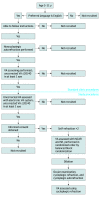Refractive Accuracy and Visual Outcome by Self-Refraction Using Adjustable-Focus Spectacles in Young Children: A Randomized Clinical Trial
- PMID: 37615952
- PMCID: PMC10450585
- DOI: 10.1001/jamaophthalmol.2023.3508
Refractive Accuracy and Visual Outcome by Self-Refraction Using Adjustable-Focus Spectacles in Young Children: A Randomized Clinical Trial
Abstract
Importance: Uncorrected refractive error is the most common cause of vision impairment in children. Most children 12 years or older can achieve visual acuity (VA) of 20/25 or better by self-refraction using adjustable-focus spectacles, but data on younger children are lacking.
Objective: To assess refractive accuracy, corrected VA, and factors associated with not achieving VA of 20/25 or better among children aged 5 to 11 years performing self-refraction with Adspecs adjustable-focus spectacles (Adaptive Eyecare), compared with noncycloplegic autorefraction and cycloplegic refraction.
Design, setting, and participants: This was a cross-sectional noninferiority trial conducted from September 2, 2015, to December 14, 2017. The study setting was an academic pediatric eye clinic. Children aged 5 to 11 years with uncorrected VA of 20/40 or worse in 1 or both eyes and without systemic or ocular conditions preventing best-corrected VA of 20/25 or better were enrolled. Children who had best-corrected VA worse than 20/25 were excluded. Study data were analyzed from September 2017 to June 2023.
Exposures: Children were taught to self-refract with adjustable-focus spectacles.
Main outcomes and measures: Spherical equivalent refractive error (using self-refraction, noncycloplegic autorefraction, and cycloplegic refraction) and VA (uncorrected and using self-refraction, noncycloplegic autorefraction, and cycloplegic refraction) for study eyes were evaluated. Potential predictors of failure to achieve VA of 20/25 or better with self-refraction were assessed using logistic regression.
Results: A total of 127 consecutive children were enrolled. After exclusions, 112 children (median [IQR] age, 9.0 [8.0-10.3] years; 52 boys [46.4%]) were included in the study. Mean (SD) spherical equivalent refractive power was -2.00 (1.52) diopters (D) for self-refraction, -2.32 (1.43) D for noncycloplegic autorefraction, and -1.67 (1.49) D for cycloplegic refraction. Mean (SD) difference in refractive power between self-refraction and noncycloplegic autorefraction was 0.32 (1.11) D (97.5% 1-sided CI, 0.11 to ∞ D; P < .001) and between self-refraction and cycloplegic refraction was -0.33 (1.15) D (97.5% 1-sided CI, -0.54 to ∞ D; P = .77). The proportion of children with corrected VA of 20/25 or better was 79.5% (89 of 112) with self-refraction, 85.7% (96 of 112) with noncycloplegic autorefraction, and 79.5% (89 of 112) with cycloplegic refraction (self-refraction vs noncycloplegic autorefraction: McNemar P value = .27; self-refraction vs cycloplegic refraction: McNemar P value > .99). Those failing to achieve best-corrected VA of 20/25 or better with self-refraction had higher astigmatism (odds ratio [OR], 10.6; 95% CI, 3.1-36.4; P < .001) and younger age (OR, 1.5; 95% CI, 1.1-2.2; P = .02).
Conclusions and relevance: Self-refraction among children aged 5 to 11 years may result in more myopic power than cycloplegic refraction but not necessarily to a clinically relevant degree. Although the proportion of children achieving VA of 20/25 or better with self-refraction using adjustable-focus spectacles did not differ from cycloplegic refraction, it was less likely among younger children and those with higher astigmatism.
Conflict of interest statement
Figures
Comment in
-
Using Adjustable-Focus Spectacles in Young Children to Meet Increasing Eyecare Needs.JAMA Ophthalmol. 2023 Sep 1;141(9):860-861. doi: 10.1001/jamaophthalmol.2023.3760. JAMA Ophthalmol. 2023. PMID: 37615948 No abstract available.
References
Publication types
MeSH terms
Substances
LinkOut - more resources
Full Text Sources
Medical


